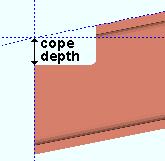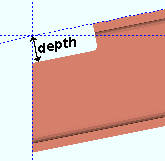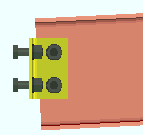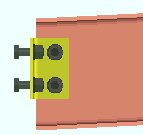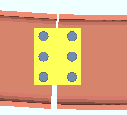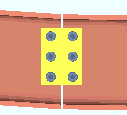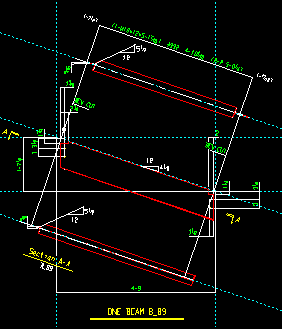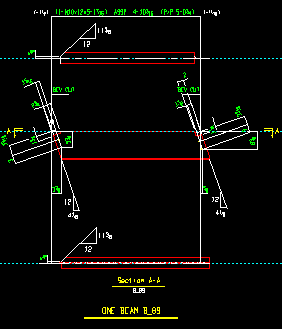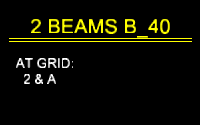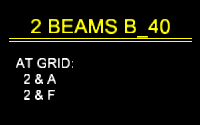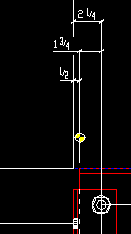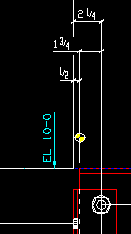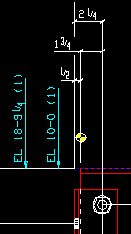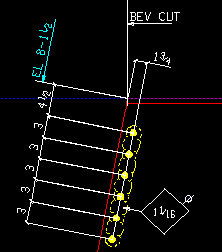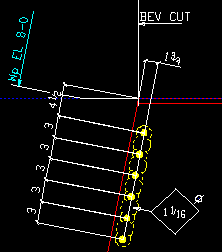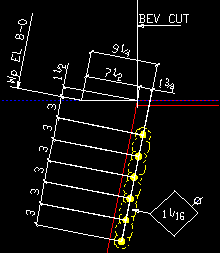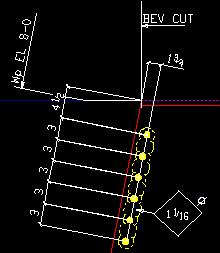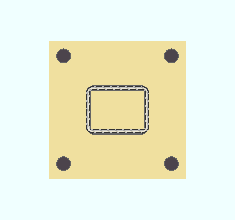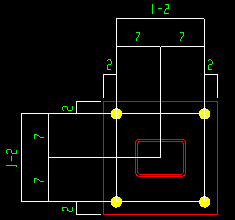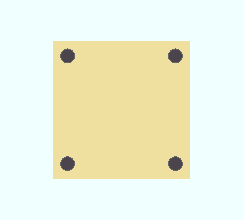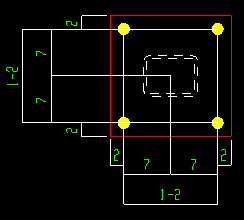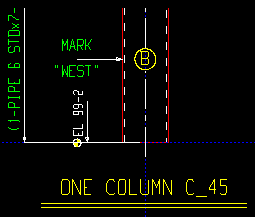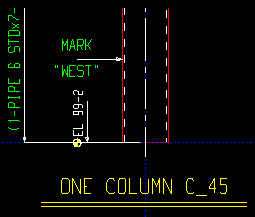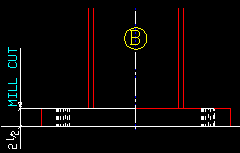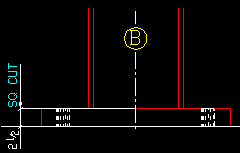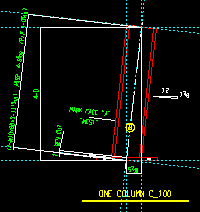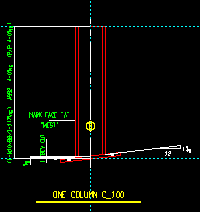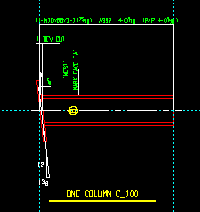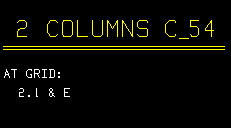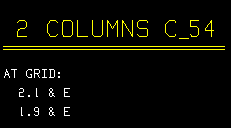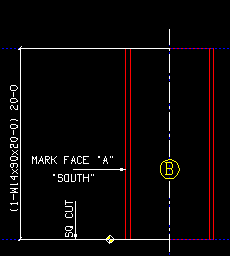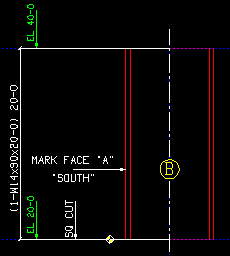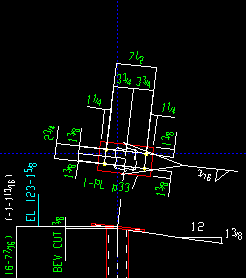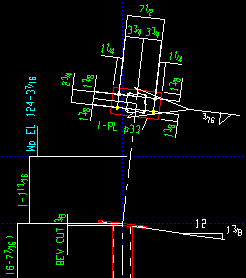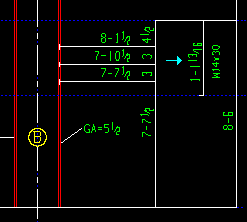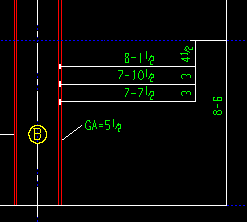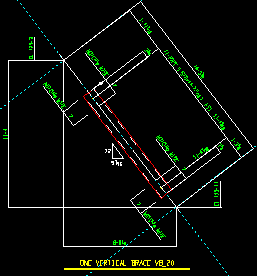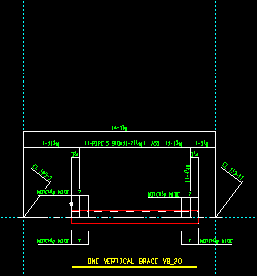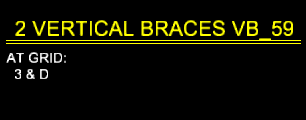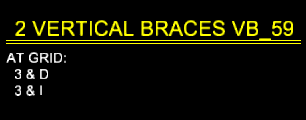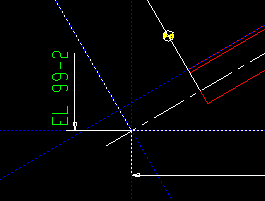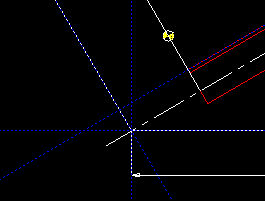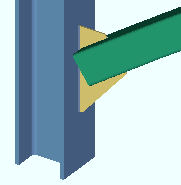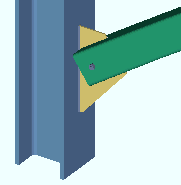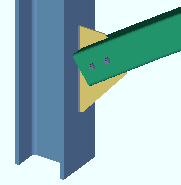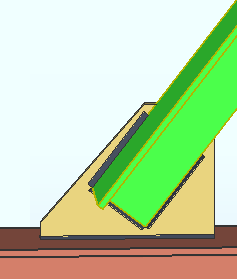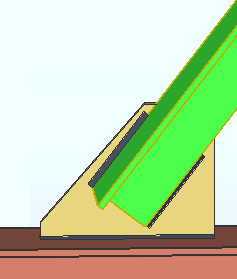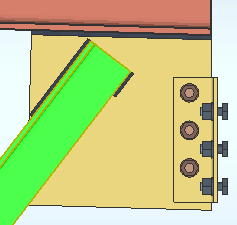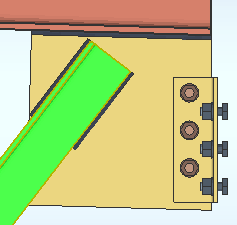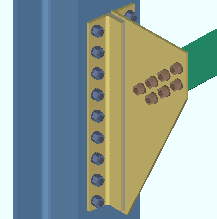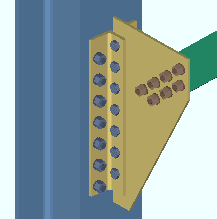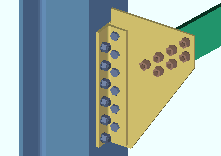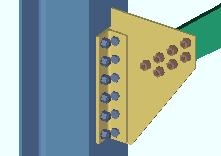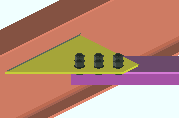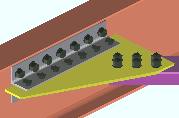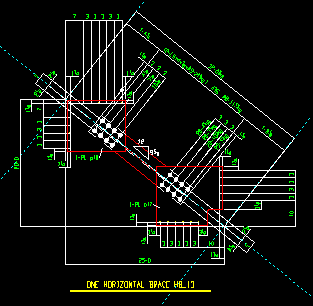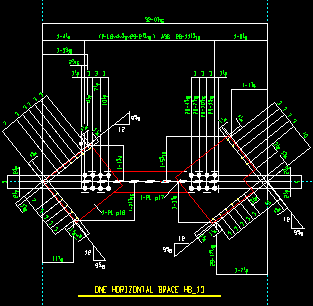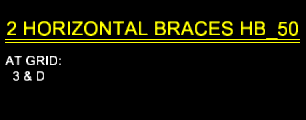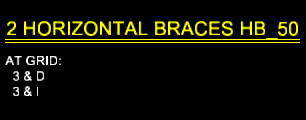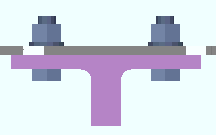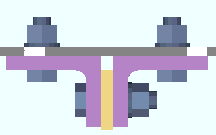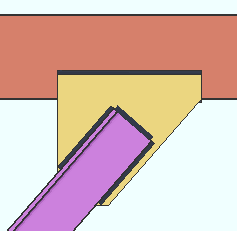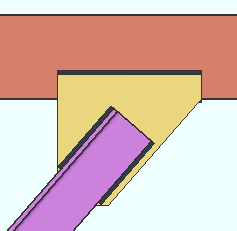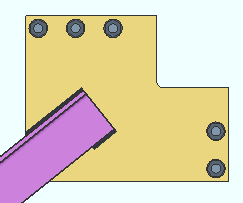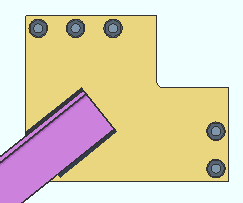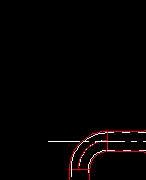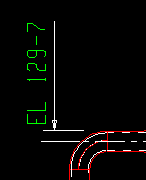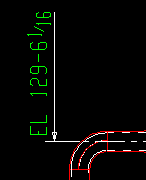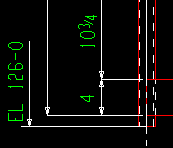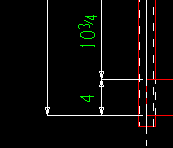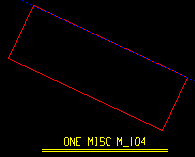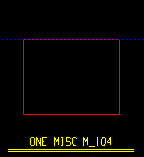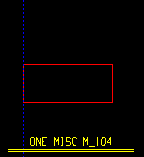The Member Detailing Settings setup window ( Fabricator Settings )
page 1 | contents | home > project settings > fabricator > detailing > | classic
To open Member Detailing Settings :
Method 1 : Home > Project Settings > Fabricator > Detailing > Member Detailing Settings .
Methods 2, 3 & 4 : In Modeling or the Drawing Editor , choose Settings > Fabricator Settings > Member Detailing Settings (classic), or use a keyboard shortcut , or click the icon.
page 1 | contents | home > project settings > fabricator > detailing > | classic | top
|
|
Preferred bottom flange view style: Cross section or Worm's eye view . This applies in a full-featured SDS2 program when the program determines that the bottom flange of a beam needs to be pictured on the beam's detail in order to show something that cannot be seen in another view. The choice made here sets which style of view will be generated. In member isolation , the view that is generated will be listed on the view list . Unless that view is deleted by the user in a full-featured SDS2 program, it will be regenerated on the beam detail during detail Members .
|
' Cross section ' causes a ' BOTTOM FLANGE VIEW, CROSS SECTION ' to be generated if it is needed.
' Worm's eye view ' causes a ' BOTTOM FLANGE VIEW ' to be generated if it is needed.
Also see: Users in a full-featured SDS2 program can use the Member View Defaults setup window to change the depth checking limits of these and other views.
Provide minimum cope depth: ![]() or
or ![]() . This applies in a full-featured SDS2 program to beams with system-designed copes when " Provide minimum cope depth " set to ' Automatic ' on their Beam windows.
. This applies in a full-featured SDS2 program to beams with system-designed copes when " Provide minimum cope depth " set to ' Automatic ' on their Beam windows.
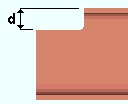
|
d = cope depth.
Click here for special-case examples. |
If this box is checked (
) and " Provide minimum cope depth " is set to ' Automatic ' on the Beam window, connection design ignores the k distance of the supporting beam when calculating the depth of the cope. A cope of minimum depth will thus be provided.
If the box is not checked (
), connection design copes the supported beam so that it clears the k distance of the supporting beam.
Other controls affecting cope depth: " Minimum cope radius center clearance " " Round cope depth to the nearest " " Cope cut type "
Minimum clearance for cope: The distance (in the primary dimension " Units " or other units ) that connection design will use, at a minimum, for the clearance between the supporting beam's flange and the flange of the supported beam that is being coped. This applies in a full-featured SDS2 program to beams with system-designed copes.
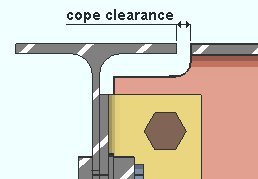
Other controls affecting cope clearance: " Round cope length to nearest "
Minimum cope radius center clearance from face of flange: The distance (in the primary dimension " Units " or in other units ) that the center of the cope must be, at minimum, from the face of the flange. This applies in a full-featured SDS2 program to beams with system-designed copes.
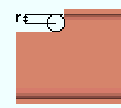
|
r = cope radius. |
Round cope length to nearest: The accuracy from 0.1 to 2 inches ( 0 to 51 mm metric ) that the length of a cope will be measured to on beams in a full-featured SDS2 program .
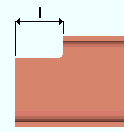
|
l = cope length. |
Round cope depth to nearest: The accuracy from 0.1 to 2 inches ( 0 to 51 mm metric ) that the depth of a cope will be measured to on beams in a full-featured SDS2 program .

|
d = cope depth.
Click here for special-case examples. |
Cope radius: The distance (in the primary dimension " Units " or other units ) from the center of the cope to any point on the coped corner's circular edge. This sets the default curvature for cope corners on members with a ' Cope plain ' operation. Users in a full-featured SDS2 program can override this default by setting a different " Cope radius " on the beam or other member type. This setup option also sets the default cope radius for " Cope plain " operations that are specified for miscellaneous members on the Rolled Section Material window.
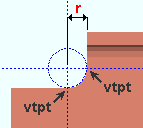
|
r = cope radius. Vertical and horizontal construction lines at the vertex points ( vtpt ) of the cope corner meet at the center point of a construction circle whose " Radius " is equal to the " Cope radius ." |
Cope cut type: perpendicular to web angle (legacy) or Parallel to flange . This applies not just to beams, but also to any member with a ' Cope plain ' operation. A full-featured SDS2 program automatically copes beams, where necessary. Generally speaking, copes for member types other than beams need to be applied by the user. This option applies to both system-generated and user-added copes. If the " Web cut " angle on the member is ' 0 ', the member's web is perpendicular to its flange, and coping the member gives the same results, no matter which selection is made here.
|
|
' perpendicular to web angle (legacy) ' causes the cope's length to be cut perpendicular to the " Web cut " angle. The " Depth " of a cope is measured parallel with the " Web cut " angle.
' Parallel to flange ' causes the cope's length to be cut parallel to the member's flange. The " Depth " of the cope is measured perpendicular to the flange.
Round off material length where possible: ![]() or
or ![]() . This applies in a full-featured SDS2 program to any beam with a clip angle or bent plate on its right end in a beam-to-beam or beam-to-column framing situation.
. This applies in a full-featured SDS2 program to any beam with a clip angle or bent plate on its right end in a beam-to-beam or beam-to-column framing situation.
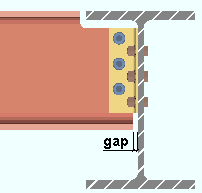
|
gap = clearance that is changed. The program decreases or increases this gap when it rounds the length of the beam's main material up or down to the nearest 1/4 inch. |
If this box is checked (
), then a beam main material's length is rounded to the nearest 1/4 inch when it has a clip angle connection is on its right end. To accomplish this, the program adjusts the right end " Material setback " to increase or decrease the clearance between the beam's right end and the face of the supporting member.
If the box is not checked (
), the program designs a clearance of 1/2 inch between that beam's left/right end and the face of the supporting member when the beam has a clip angle or shear plate or bent plate. The length of the beam's main material is calculated to the nearest 1/16 inch.
Member end edge distance: The distance (in the primary dimension " Units " or in other units ) from the edge of the beam to the center of the first column of holes. This distance is measured parallel with the workline of the beam and may be applied when beams undergo Process and Create Solids in a full-featured SDS2 program .
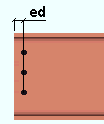
|
ed = edge distance. |
Square cut ends of sloped beams: ![]() or
or ![]() . This applies (in a full-featured SDS2 program ) to the ends of slightly sloping beams with clip angles , shear tabs , shear thru plates or bent plates .
. This applies (in a full-featured SDS2 program ) to the ends of slightly sloping beams with clip angles , shear tabs , shear thru plates or bent plates .
|
|
If this box is checked (
), then the end of a sloping beam will be cut square, while the connection's face is flat against the member being framed to. If the connection is unable to stand up to the load, the program bevel cuts the beam (as if this option were not checked) instead of failing the connection.
If the box is not checked (
), the beam is automatically bevel cut so that its framing edge is parallel with the face of connection and the member it frames to.
Square cut ends for spliced beam connection: ![]() or
or ![]() . This applies to ' Non-moment ' splice plates on beams at different slopes.
. This applies to ' Non-moment ' splice plates on beams at different slopes.
|
|
If this box is checked (
), connection design a full-featured SDS2 program attempts to square cut both beams. If the program determines that the resulting gap between the beams would be larger than 1.5 inch (38 mm), the program will bevel cut both beams (instead of failing the connection). Both beams must also be the same depth.
If the box is not checked (
), the program bevel cuts both of the beams.
Detailed: In position or Horizontal . This applies to the details of beams automatically detailed in a full-featured SDS2 program .
|
Show design loads on details: None or Input or All . This applies to the details of beams automatically detailed in a full-featured SDS2 program . If ' Input ' or ' All ' is selected, users of the program can additionally choose to " Show member quantities " and/or " Show member numbers ."
| Loads on the left end, Beam Review window : |

|
| ' Input ' loads on the beam detail, left end : |

|
| ' All ' loads on the beam detail, left end : |

|
' None ' means that no notes on design loads will be placed on beam details subsequently generated in a full-featured SDS2 program .
' Input ' causes loads that have been entered by the user (this can be reviewed on the Beam Review window) to be reported on beam details that are subsequently generated.
' All ' causes all loads other than loads of ' 0 ' to be noted on beam details that are subsequently generated.
![]() /
/ ![]() Show member quantities and/or
Show member quantities and/or ![]() /
/ ![]() Show member numbers. This applies to beams subsequently auto detailed (in a full-featured SDS2 program ) when " Show design loads on details " is set to ' Input ' or to ' All '. Multiple beams with the same system piecemark can have different design loads.
Show member numbers. This applies to beams subsequently auto detailed (in a full-featured SDS2 program ) when " Show design loads on details " is set to ' Input ' or to ' All '. Multiple beams with the same system piecemark can have different design loads.
| Each of these examples is from a detail of four beams combined under the same piecemark. Two of the beams -- member numbers [90] [91] -- have a user input " Shear load " of 24.0 kips. The other two beams -- [92] [93] -- have an automatically calculated " Shear load " of 24.7 kips. | ||
|
Example 1 : " Show design loads ... " is ' Input '. " |
|
|
Example 2 : " Show design loads ... " is ' All '. " |
|
|
Example 3 : " Show design loads ... " is ' All '. " |
|
Show capacity loads on details: None or All . This applies to automatic detailing of beams (in a full-featured SDS2 program ). The capacity loads shown on the detail should match the Connection Design Calculations and Expanded Connection Design Calculations so long as everything -- the design calcs, the model and the detail -- is all up to date.
| Connection capacity loads ( Calcs ) : |

|
| " Show capacity loads on details " = ' All ' : |

|
' None ' means connection capacity loads will not be shown on subsequently generated details of beams.
' All ' results in connection capacity loads being shown on beam details subsequently generated in a full-featured SDS2 program .
![]() /
/ ![]() Show member quantities and/or
Show member quantities and/or ![]() /
/ ![]() Show member numbers. This applies to beams subsequently auto detailed (in a full-featured SDS2 program ) when " Show capacity loads on details " is set to ' All '.
Show member numbers. This applies to beams subsequently auto detailed (in a full-featured SDS2 program ) when " Show capacity loads on details " is set to ' All '.
Theoretically, if the beam has a system piecemark , corresponding end connections for all beams that share that same piecemark should all have the same capacity. This means that the same member quantity and member numbers should theoretically be listed for each capacity load.
Show grid notes on details: ![]() None or
None or ![]() One or
One or ![]() all . This applies to beams that were automatically detailed in a full-featured SDS2 program .
all . This applies to beams that were automatically detailed in a full-featured SDS2 program .
|
'
None ' indicates that no grid-location notes were added to beam details that were automatically detailed while ' None ' was selected.
'
One ' indicates that automatic detailing has been instructed to add to a detail a grid location note stating the plan view grid intersection that is closest to the origin reference point (left-end workpoint) of the bottom, left beam that is under the particular piecemark that was being automatically detailed. The bottom beam in a plan view is the beam with the lowest Y global coordinate . The left beam in a plan view is the beam with the lowest X global coordinate.
'
All ' indicates that automatic detailing has been instructed to add to a detail the grid intersections for each beam with the same piecemark. The beam locations are listed according to their bottom-to-top and left-to-right locations in a plan view. For beams that have the same X-Y global coordinates , the beam at the lower elevation is listed first.
Show end elevations on details: None or First or All . This applies to the details of beams automatically detailed in a full-featured SDS2 program .
|
If ' None ' is selected, end elevations will not be shown on beam details subsequently generated in a full-featured SDS2 program .
If ' First ' is selected, the end elevation of the beam with the lowest member number will be shown on a system-generated beam detail. The elevation will be shown on the left end for a non-sloping beam; both end elevations will be shown for a sloping beam.
If ' All ' is selected, the quantity and elevation of beams with the same piecemark that are at different elevations will be noted on the beam detail.
End elevation reference point: Material end or Work point. This applies to the details of beams automatically detailed in a full-featured SDS2 program . On details of non-sloping beams, the same elevations will be reported regardless of the choice shown here.
|
' Material end ' causes the end elevations shown on the beam detail to be the top flange elevation at the right/left edge of the beam's main material. The annotation "EL" will appear on the member detail.
' Work point ' causes the end elevations shown on the beam detail to be the " End elevations " of the right/left beam work points. The annotation "Wp" (instead of "EL") will appear on the member detail.
Add work point dimensions: ![]() or
or ![]() . When automatic detailing takes place in a full-featured SDS2 program , the choice shown here applies to details of sloping beams if ' Work Point ' is selected for " End elevation reference point ."
. When automatic detailing takes place in a full-featured SDS2 program , the choice shown here applies to details of sloping beams if ' Work Point ' is selected for " End elevation reference point ."
|
If this box is checked (
), dimensions are generated from the work point to, for example, the end of the material.
If the box is not checked (
), only the work point elevation is noted.
Show camber on the bill of material: ![]() or
or ![]() . This applies to the bills of material that are generated when automatically detailing beams with camber in a full-featured SDS2 program .
. This applies to the bills of material that are generated when automatically detailing beams with camber in a full-featured SDS2 program .
| Entry made here, in setup : |
|
|
| " Camber annotation " on the Beam Review window : |
|
|
| Camber in the " Remarks " column on the bill : |

|
If this box is checked (
), the characters that are entered here, along with the " Mid-ordinate " distance entered for " Camber annotation " on the Beam Review window, are automatically compiled into the " Remarks " column of the beam's bill of material during automatic detailing . Exception: If ' 0 ' is entered as the " Mid-ordinate " camber on the Beam Review window, camber is not shown in the bill of material.
If the box is not checked (
), camber is not written to the " Remarks " column of the bill of material during automatic detailing .
page 1 | contents | home > project settings > fabricator > detailing > | classic | top
|
|
Preferred baseplate view orientation: ![]() Bird's eye view or
Bird's eye view or ![]() Worm's eye view .
Worm's eye view .
| Bird's eye view: | ||||||
|
||||||
| Worm's eye view: | ||||||
|
For columns subsequently processed and detailed in a full-featured SDS2 program . . .
'
Bird's eye view ' results in column details depicting top-down views of base plates. In member isolation , these views are named "BOTTOM END VIEW, CROSS SECTION."
'
Worm's eye view ' makes those column details depict a bottom-up view of their base plates. In member isolation, this view is named "BOTTOM END VIEW."
Show C face on details: As required or Always or Never . On a wide flange or tube column detail, face B is web near side. Face C is the flange on the right when you are looking at face B.
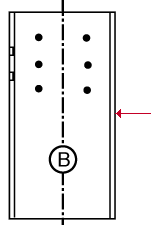
|
face C |
For columns subsequently processed and detailed in a full-featured SDS2 program . . .
'
As required ' results in a view of the C face being drawn on a column detail when the C face needs to be represented on that detail in order to ensure that holes and submaterials are correctly added to that column in the shop.
'
Always ' puts a view of the C face on the details of those subsequently processed and detailed columns.
'
Never ' results in the C face not being drawn on the columns details.
Show A face on details: As required or Always or Never . On a wide flange or tube column detail, face B is web near side. Face A is the left flange when you are looking at face B.
| face A |
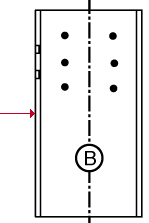
|
For columns subsequently processed and detailed in a full-featured SDS2 program . . .
'
As required ' results in a view of the A face being drawn on a column detail when the A face needs to be represented on that detail in order to ensure that holes and submaterials are correctly added to that column in the shop.
'
Always ' puts an A-face view on the details of thos subsequently processed and detailed columns.
'
Never ' results in the A face not being drawn on the columns details.
Annotate faces of pipe on details: ![]() or
or ![]() . This applies to the details of HSS round (pipe) columns that are automatically detailed in a full-featured SDS2 program .
. This applies to the details of HSS round (pipe) columns that are automatically detailed in a full-featured SDS2 program .
|
If this box is checked (
), then faces are annotated as (A) or (B) or (C) on pipe columns.
If the box is not checked (
), the faces of columns are not annotated on pipe columns.
Mill cut column ends: ![]() or
or ![]() . This affects labeling only . It applies to the details of columns automatically detailed in a full-featured SDS2 program .
. This affects labeling only . It applies to the details of columns automatically detailed in a full-featured SDS2 program .
|
If this box is checked (
), the ends of columns with end cuts are labeled on details to be "MILL CUT."
If the box is not checked (
), the ends of columns with end cuts are labeled on details to be "SQ CUT."
Show erection pin holes: ![]() or
or ![]() . An erection pin hole is a lift hole near the top of a column that can be used by a crane to lift the column into place. This sets the default for " Erection pin hole " on a Column window.
. An erection pin hole is a lift hole near the top of a column that can be used by a crane to lift the column into place. This sets the default for " Erection pin hole " on a Column window.
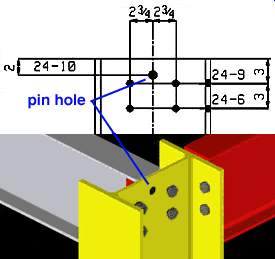
|
Note: Connection design does not automatically design an erection pin hole in this situation since the pin hole interferes with the clip angle on the beam. To get a pin hole, the user has to select ' Yes ' instead of ' Automatic ' on the Column Edit window. |
If this box is checked (
) and ' Automatic ' is selected for " Erection pin hole " on the Column Review window, then a full-featured SDS2 program will design an erection pin hole on that column. Exception: A pin hole is not automatically designed if it interferes with a connection to the column.
If the box is not checked (
) and ' Automatic ' is selected for " Erection pin hole " on the Column window, an erection pin hole is not designed.
Erection pin holes are CNC downloadable: ![]() or
or ![]() .
.
If this box is checked (
), erection pin holes on columns are, by default, able to be downloaded to a CNC punch or drill using the SDS2 CNC Module.
If the box is not checked (
), erection pin holes are, by default, not able to be downloaded.
Tip: You can review the status of individual erection pin holes in the model using Hole Review to see which option is selected for the " Valid for CNC downloading " field on the Edit 3D Hole window.
Erection pin hole diameter: The erection pin hole diameter (in the primary dimension " Units " or in other units ). Per OSHA requirements, the default diameter is 2 inches (51 mm). The upper limit is 5 inches (125 mm).
Vertical edge distance of hole: The distance (in the primary dimension " Units " or in other units ) from the top edge of the column to the center of the first row of holes. This applies to columns that subsequently undergo Process and Create Solids in a full-featured SDS2 program .
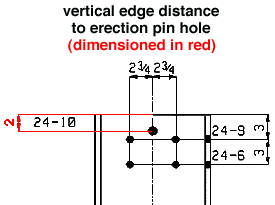
Detailed: In position or Vertical or Horizontal . This applies to the details of columns automatically detailed in a full-featured SDS2 program .
|
Show design loads on details: None or Input or All . This applies to the details of columns automatically detailed in a full-featured SDS2 program .
| Loads on the top end, Column Review window : |

|
| ' Input ' top end loads on the column detail : |

|
| ' All ' top end loads on the column detail : |

|
' None ' results in design loads not being shown on column details.
' Input ' results in only those loads that have been entered by the user (on the Column window) being reported on column details.
' All ' results all design loads -- except loads of ' 0 ' -- being noted on the column detail.
![]() /
/ ![]() Show member quantities and/or
Show member quantities and/or ![]() /
/ ![]() Show member numbers. This applies to columns subsequently auto detailed (in a full-featured SDS2 program ) when " Show design loads on details " is set to ' Input ' or to ' All '. Multiple columns with the same system piecemark can have different design loads.
Show member numbers. This applies to columns subsequently auto detailed (in a full-featured SDS2 program ) when " Show design loads on details " is set to ' Input ' or to ' All '. Multiple columns with the same system piecemark can have different design loads.
| These examples are from a detail of two columns combined under the same piecemark. One column -- member number [36] -- has a user-input " Load " of 10.0 kips . The other column -- [37] -- has a user-input 6.0 kips . | ||
|
Example 1 : " Show design loads ... " is ' Input '. " |
|
|
Example 2 : " Show design loads ... " is ' All . " |
|
If this box is checked (
), connection capacity loads will be shown on the column details subsequently generated in a full-featured SDS2 program .
If the box is not checked (
), connection capacity loads will not be shown on subsequently generated details of columns.
Show capacity loads on details: None or All . This applies to the automatic detailing of columns (in a full-featured SDS2 program ). The capacity loads shown on the detail should match the Connection Design Calculations and Expanded Connection Design Calculations so long as everything -- the design calcs, the model, the detail -- is all up to date.
| Connection capacity loads ( Calcs ) : |
|
|
| " Show capacity loads on details " = ' All ' : |

|
' None ' means that connection capacity loads will not be reported on column details.
' All ' results in connection capacity loads being reported on column details that are subsequently generated in a full-featured SDS2 program .
![]() /
/ ![]() Show member quantities and/or
Show member quantities and/or ![]() /
/ ![]() Show member numbers. This applies to columns auto detailed (in a full-featured SDS2 program ) when " Show capacity loads on details " is set to ' All '.
Show member numbers. This applies to columns auto detailed (in a full-featured SDS2 program ) when " Show capacity loads on details " is set to ' All '.
Theoretically, if the column has a system piecemark , corresponding end connections for all columns that share that same piecemark should all have the same capacity. This means that the same member quantity and member numbers should theoretically be listed for each capacity load.
Show grid notes on details: None or One or All . This applies to the details of columns automatically detailed in a full-featured SDS2 program .
|
' None ' prevents grid locations from being listed on the column detail.
' One ' instructs automatic detailing to list only the grid intersection for the bottom, left column.
' All ' instructs automatic detailing to list grid intersections for each column that has the same piecemark. The column locations will be listed based on their left to right and bottom to top locations in a plan view. For example: You have four columns with the same piecemark, two on one horizontal grid line, two on another horizontal grid line. The first grid location listed on the detail of these columns is for the left column on the bottom grid line. The second grid location is for the right column on that same grid line. The third grid location is for the left column on the upper grid line. The fourth grid location is for the right column on the upper grid line.
Show end elevations on details: None or First . This applies to the details of columns automatically detailed in a full-featured SDS2 program .
|
' None ' prevents member end elevations from being shown on subsequently detailed columns.
' First ' causes the elevations for the column with the lowest member number to be shown on subsequently detailed columns. The end elevations of the column as well as members framing into the column will be shown.
Top elevation reference point: Material end or Work point . This applies to the details of columns that are automatically detailed in a full-featured SDS2 program and when ' First ' is selected for " Show end elevations on details ." The top end of a column's material may be different from its top-end work point when, for example, the column's work point is to the workline of a cantilevered beam.
|
If ' Material end ' is selected, the column's top-end elevation is annotated as being at the point where the workline of the column intersects the top edge of the column's main material.
If ' Work point ' is selected, the column's top-end elevation is annotated as being at the top-end work point of the column.
Show sections framing into column: ![]() or
or ![]() . This applies to the details of columns that are automatically detailed in a full-featured SDS2 program .
. This applies to the details of columns that are automatically detailed in a full-featured SDS2 program .
|
If this box is checked (
), the program dimensions the depth of members framing into columns and identifies the section sizes of those members. This helps checkers to ensure that members will fit up correctly at the construction site.
If the box is not checked (
), the program does not dimension the depth of members framing into columns, nor does it identify the section sizes of those members.
------ Shear thru plates ------
HSS notch radius: ![]() Auto or 0 or a radius (in the primary dimension " Units " or other units ). The radius is for the circular cutouts at the ends of the notch in an HSS column ( pipe or tube ) that is framed to by a beam (or two opposing beams) which have thru shear plate connections. The notch is generated for inserting the thru shear plate into.
Auto or 0 or a radius (in the primary dimension " Units " or other units ). The radius is for the circular cutouts at the ends of the notch in an HSS column ( pipe or tube ) that is framed to by a beam (or two opposing beams) which have thru shear plate connections. The notch is generated for inserting the thru shear plate into.
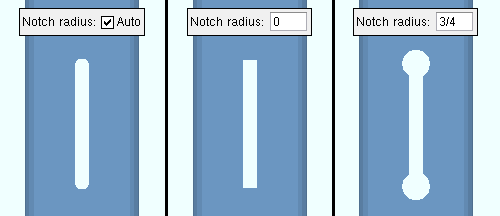
When a shear "
Thru shear plate " is designed:
'
Auto (checked) ' puts a circular cutout at each end of a square-cornered notch. Each of these circular cutouts has a radius that is half the notch width and is centered at where the center of the horizontal edge of a square-cornered notch would be.
' 0 ' (with "
Auto " not checked) creates a square-cornered notch.
' a radius ' (with "
Auto " not checked) adds a circular cutout on each end of the square-cornered notch. Each circular cutout -- if sufficiently large -- is the specified radius and is centered at where the center of the horizontal edge of a square-cornered notch would be. If the radius that is entered here is smaller than half the thickness of the thru shear plate, the circular cutout's radius is made to be half the thickness of the thru shear plate.
Note: The notch width is equal to the sum of the thickness of the shear through plate and the " Total notch width clearance " that is entered below.
Total notch width clearance: The clearance (in the primary dimension " Units " or other units ) for the shear thru plate that is inserted into a notch in an HSS ( pipe or tube ) column.

|
| " Total notch width clearance " is equal to the notch width minus the stiffener thickness. |
Effect on connection design in a full-featured SDS2 program: The entry made here controls the " Notch width " that connection design creates in the column that a shear thru plate frames through. A shear thru plate is designed for beam-to-HSS-column framing situations when the beam's " Input connection type " is ' Shear ' and " Thru shear plate '' is set to ' Thru plate ' or ' Split plate ' under "
Connection specifications " on the Beam Review window. Connection design first determines the thickness and other dimensions of the thru plate, then uses the " Total notch width clearance " to calculate the required notch size. " HSS notch radius " (above) also affects the design of the notch.
page 1 | contents | home > project settings > fabricator > detailing > | classic | top
|
|
------ Vertical braces ------
Locate angle braces on neutral axis: ![]() or
or ![]() . This applies to vertical braces with angle material entered as the " Section size " when " Locate on neutral axis " is set to ' Automatic ' on the Vertical Brace Review window.
. This applies to vertical braces with angle material entered as the " Section size " when " Locate on neutral axis " is set to ' Automatic ' on the Vertical Brace Review window.
|
workline ( x )
on neutral axis |
workline ( x )
on gage line |

|
|
If this box is checked (
), connection design orients the brace's angle material so that the angle's X-X axis or Y-Y axis intersects with the work line of the brace.
If the box is not checked (
), connection design aligns the gage line of the angle material with the work line of the brace.
Minimum member end edge distance: The distance (in the primary dimension " Units " or in other units ) parallel with the workline of the vertical brace from the edge of the brace to the center of the nearest hole.
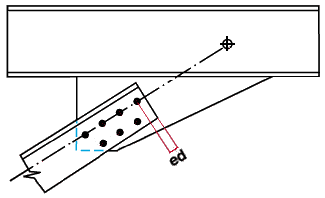
|
ed = edge distance for a vertical brace. |
Note: If an extremely low edge distance is shown here (for example, 1/8 inch), connection design will calculate the minimum edge distance based on the bolt diameter.
Gusset to supporting beam connection: Welded or Clip angle . This applies when ' Automatic ' is selected for " Gusset to beam connection " on the Vertical Brace Review window in the following framing situations:
|
' |
' |
|
| Case 1 : vertical brace to beam only |
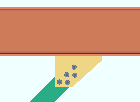
|
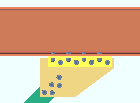
|
| Case 2 : vertical brace to column only |

|

|
| Case 3 : beam on a vbrc to beam & column when a clip angle bolts to the column |
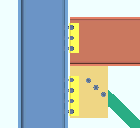
|
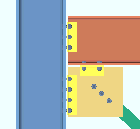
|
| Case 4 : vertical brace to a wide flange vertical brace |

|

|
Detailed: In position or Horizontal . This applies to the details of vertical braces automatically detailed in a full-featured SDS2 program .
|
Show design loads on details: None or Input or All . This applies to the details of vertical braces automatically detailed in a full-featured SDS2 program .
| Loads on the right end, Vertical Brace Review window : |

|
| ' Input ' loads on the vertical brace detail, right end : |

|
| ' All ' loads on the vertical brace detail, right end : |

|
' None ' results in design loads not being shown on vertical brace details.
' Input ' results in only those loads that have been entered by the user (on the Vertical Brace Review window) being reported on vertical brace details.
' All ' results all design loads -- except loads of ' 0 ' -- being noted on the vertical brace detail.
![]() /
/ ![]() Show member quantities and/or
Show member quantities and/or ![]() /
/ ![]() Show member numbers. This applies to vertical braces auto detailed (in a full-featured SDS2 program ) when " Show design loads on details " is set to ' Input ' or to ' All '. Multiple vertical braces with the same system piecemark can have different design loads.
Show member numbers. This applies to vertical braces auto detailed (in a full-featured SDS2 program ) when " Show design loads on details " is set to ' Input ' or to ' All '. Multiple vertical braces with the same system piecemark can have different design loads.
| Each of these examples is from a detail of two vertical braces combined under the same piecemark. One brace -- member number [63] -- has a user-input " Tension load " of 50.0 kips. The other brace -- [151] -- has a user-input " Tension load " of 46.0 kips. | ||
|
Example 1 : " Show design loads ... " is ' Input '. " |
|
|
Example 2 : " Show design loads ... " is ' Input '. " |
|
|
Example 3 : " Show design loads ... " is ' Input '. " |
|
Show capacity loads on details: None or All . This applies to the automatic detailing of vertical braces (in a full-featured SDS2 program ). The capacity loads shown on the detail should match the Connection Design Calculations and Expanded Connection Design Calculations so long as everything -- the design calcs, the model, the detail -- is all up to date.
| Connection capacity loads ( Calcs ) : |

|
| " Show capacity loads on details " = ' All ' : |

|
' None ' means connection capacity loads will not be shown on subsequently generated details of vertical braces.
' All ' results in the connection capacity loads being shown on vertical brace details subsequently generated in a full-featured SDS2 program .
![]() /
/ ![]() Show member quantities and/or
Show member quantities and/or ![]() /
/ ![]() Show member numbers. This applies to vertical braces auto detailed (in a full-featured SDS2 program ) when " Show capacity loads on details " is set to ' All '.
Show member numbers. This applies to vertical braces auto detailed (in a full-featured SDS2 program ) when " Show capacity loads on details " is set to ' All '.
Theoretically, if the vertical brace has a system piecemark , corresponding end connections for all vertical braces that share that same piecemark should all have the same capacity. This means that the same total member quantity and member numbers should theoretically be listed for each capacity load.
Show grid notes on details: ![]() None or
None or ![]() One or
One or ![]() all . This applies when vertical braces are automatically detailed in a full-featured SDS2 program .
all . This applies when vertical braces are automatically detailed in a full-featured SDS2 program .
|
'
None ' indicates that no grid-location notes were added to vertical brace details that were automatically detailed while ' None ' was selected.
'
One ' indicates that automatic detailing has been instructed to add to a detail a grid location note stating the plan view grid intersection that is closest to the origin reference point (left-end workpoint) of the bottom, left vertical brace that is under the particular piecemark that was being automatically detailed. The bottom vertical brace in a plan view is the brace with the lowest Y global coordinate . The left vertical brace in a plan view is the brace with the lowest X global coordinate.
'
All ' indicates that automatic detailing has been instructed to add to a detail the grid intersections for each brace with the same piecemark. The vertical brace locations are listed according to their bottom-to-top and left-to-right locations in a plan view. For vertical braces that have the same X-Y global coordinates , the brace at the lower elevation is listed first.
Show end elevations at workpoints on details: ![]() or
or ![]() . This applies when vertical braces are automatically detailed in a full-featured SDS2 program .
. This applies when vertical braces are automatically detailed in a full-featured SDS2 program .
|
If this box is checked (
), subsequently detailed vertical brace details will depict member end elevations . If the vertical brace detail represents multiple vertical braces with the same piecemark , the end elevations that will be shown on the drawing will be those of the one vertical brace that has the lowest member number .
If the box is not checked (
), subsequently detiailed vertical braces will not have their end elevations shown on their details.
HSS erection bolts: None or One or Two . This applies in a full-featured SDS2 program when ' Automatic ' is selected for the " Erection bolts " field on a Vertical Brace window. Erection bolts may be designed on a pipe/tube vertical brace that is field welded to the gusset.
|
|
|
' None ' instructs the program to (when ' Automatic ' is selected) not generate an erection bolt or design holes into the pipe or tube vertical brace.
' One ' instructs the program to (when ' Automatic ' is selected) generate an A307 field erection bolt along with holes for inserting the bolt into.
' Two ' instructs the program to (when ' Automatic ' is selected) generate two A307 field erection bolts along with holes for inserting the bolts into.
Hole type for HSS erection bolts: Standard round or Short slot or Long slot or Oversized round or User slot #1 or User slot #2 . This applies (to the gusset, not the brace) when " HSS erection bolts " has been set to ' One ' or ' Two '.

Effect on full-featured SDS2 programs: The hole type selected here applies to the holes in the gusset only. The holes in the brace are always standard round. Erection bolts may be designed in a full-featured SDS2 program on an HSS/pipe/tube vertical brace that is field welded to the gusset.
Intersection gusset notch preparation: Rounded slot or Weld around end . This applies to vertical brace intersection plates for X bracing when the supporting vertical brace is a HSS ( pipe or tube ). The supporting vertical brace in X bracing is the brace that the supported vertical braces frame to. The intersection plate shop welds to this brace.
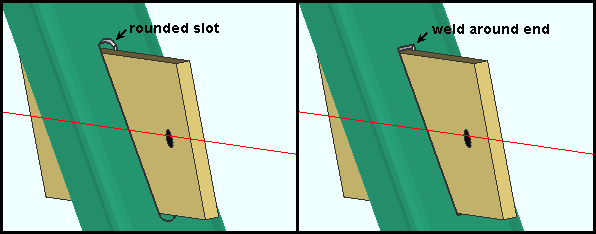
|
| When two vertical braces frame to opposite sides of an HSS brace, NS and FS notches are created for inserting the intersection plate into. |
In a full-featured SDS2 program . . .
' Rounded slot ' instructs connection design to create NS and FS notches with rounded ends. The entry made to " HSS notch radius " and " Total notch clearance " controls the rounding.
' Weld around end ' instructs connection design to create NS and FS notches with squared ends. The " Total notch clearance " controls how tightly the inserting is fit around the intersection plate.
HSS notch radius: ![]() Auto or 0 or a radius (in the primary dimension " Units " or other units ). In a full-featured SDS2 program , this sets the radius of the circular cutout at the interior end of the notch on the end of an HSS ( pipe or tube ) vertical brace. The notch is generated for inserting the gusset plate into. A hole at the end of the inserting can be generated with a CNC machine to make fabrication of the inserting easier. This also applies to intersection gusset plates when ' Rounded slot ' is selected.
Auto or 0 or a radius (in the primary dimension " Units " or other units ). In a full-featured SDS2 program , this sets the radius of the circular cutout at the interior end of the notch on the end of an HSS ( pipe or tube ) vertical brace. The notch is generated for inserting the gusset plate into. A hole at the end of the inserting can be generated with a CNC machine to make fabrication of the inserting easier. This also applies to intersection gusset plates when ' Rounded slot ' is selected.
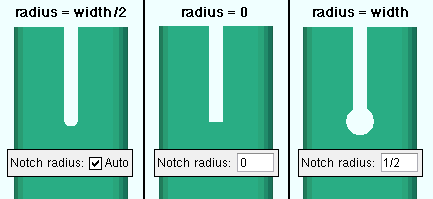
|
|
In these examples, the notch width is 1/2 inch. ' |
'
Auto (checked) ' rounds the end of the notch by adding a circular cutout that has a radius that is equal to half the notch width. The circular cutout is centered at where the center of the interior edge of a squared notch would be. On a inserting for an intersection gusset plate, both ends of the inserting are rounded.
' 0 ' (with "
Auto " not checked) squares off the corners at the interior end of the notch. This is the way that notches for gusset plates in HSS braces were modeled in versions of SDS2 software prior to v7.2. On a inserting for an intersection plate, both ends of the inserting are squared.
' a radius ' (with "
Auto " not checked) adds a circular cutout that is the specified radius at the interior end of the notch. The circular cutout is centered at where the center of the interior edge of a squared notch would be. On a inserting for an intersection gusset plate, both ends of the inserting are rounded.
Total notch width clearance: The clearance (in the primary dimension " Units " or other units ) for a gusset plate that is inserted into the notch in an HSS section when the " Pipe/tube end-fitting " is ' Welded '. When the " Pipe/tube end-fitting " is ' Paddle plate ', this is the clearance between the paddle plate and the notch in the HSS section. When the " Connection arrangement " for a wide flange vertical brace is ' Paddle plate ', this is the clearance between the gusset and the notch in the paddle plate. Connection design uses the clearance that is entered here to determine the " Notch width " in the HSS section or, for a wide flange vertical brace paddle plate connection, the " Notch width " in the paddle plate.
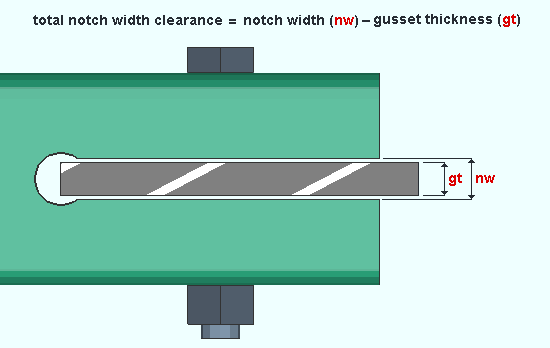
|
| This example shows a connection like you would get when " Pipe/tube end-fitting " is ' Welded '. As stated above, the " Total notch width clearance " also applies to other types of connections. |
HSS double paddle clearance: The clearance (in the primary dimension " Units " or other units ) for the gusset plate that is sandwiched between the double paddle plates in a vertical brace's double paddle plate connection.
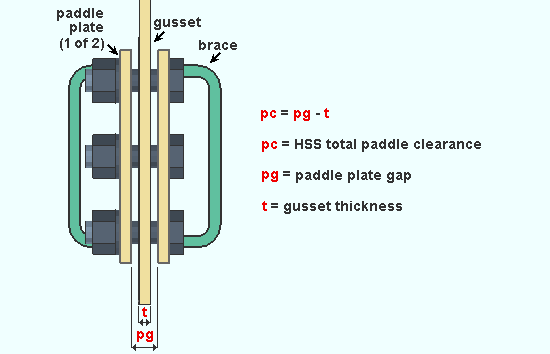
|
| " HSS double paddle clearance " is equal to the paddle plate gap minus the gusset thickness. |
Effect on connection design in a full-featured SDS2 program: The entry made here controls the spacing between the double paddle plates that connection design creates when ' Double paddle plate ' has been selected as a vertical brace's " Pipe/tube end fitting ."
Welded angle end weld: ![]() or
or ![]() . This applies when ' Automatic ' is selected for " Include end welds " under "
. This applies when ' Automatic ' is selected for " Include end welds " under " ![]() Connection specifications " on the Vertical Brace Review window.
Connection specifications " on the Vertical Brace Review window.
|
|
In a full-featured SDS2 program . . .
If this box is checked (
) and " Include end welds " is set to ' Automatic ', three sides of the angle are welded to the gusset plate. A weld is placed at the end of the angle along with the welds along the length of the angle.
If the box is not checked (
) and " Include end welds " is set to ' Automatic ', two sides of the angle are welded to the gusset plate. The two welds are along the length of the angle.
Welded angle balanced welds: This applies when ' Automatic ' is selected for " Balanced welds " under " ![]() Connection specifications " on the Vertical Brace Review window.
Connection specifications " on the Vertical Brace Review window.
|
|
In a full-featured SDS2 program . . .
If this box is checked (
) and " Balanced welds " is set to ' Automatic ', the program is instructed to attempt to design a weld group that is balanced. A weld group is balanced when its center of resistance aligns with the center of force.
If the box is not checked (
) and " Balanced welds " is set to ' Automatic ', the program is instructed to design welds of equal length along the length of the brace.
Maximum web stiffener thickness: The maximum thickness (in the primary dimension " Units " or other units ) of stiffeners for vertical brace gusset plates that weld to a beam's web.
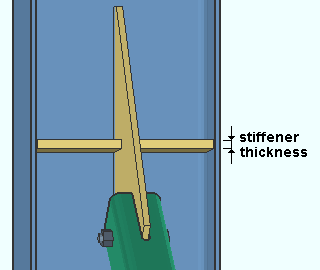
|
In a full-featured SDS2 program, connection design may create stiffeners for a vertical brace gusset plate to a beam's web when " Check supporting member web stress " is set to ' As required ' in the vertical brace's " Connection specifications ." |
Avoiding connection failure: A vertical brace gusset plate connection may fail with the message " Supporting web/flg overstressed by axial load " if the " Maximum web stiffener thickness " that is entered here is too low.
------ Clip angle connection of gusset to supporting member ------
Gusset to clip connection: Welded or Bolted . This applies to connection design in a full-featured SDS2 program when " Gusset to clip connection " is set to ' Automatic ' on the Vertical Brace Review window.
|
|
' Welded ' instructs the program to shop weld the clip angle to the gusset plate.
' Bolted ' instructs the program to attempt to shop bolt the clip angle to the gusset plate and leave a half-inch clearance (13 mm) between the gusset and the face of the supporting member. Connection design may change the connection to welded instead of failing the connection.
Clip angle size: The section size of the angle material to be used for both the near side and far side clip angles when " Clip angle size " is set to " ![]() Auto " on the Vertical Brace Review window.
Auto " on the Vertical Brace Review window.
How connection design applies this angle: If the angle works when connection design creates the connection in a full-featured SDS2 program , the program uses it. If it doesn't work, the program tries to select an angle from the miscellaneous " Preferred Angle Sizes " setup list. If none of those angles work, the program chooses an angle from the local shape file .
Attach long leg to: Supported or Supporting . This applies to angles with unequal legs when " Attach long leg to " is set to ' Automatic ' on the Vertical Brace Review window.
' Supported ' fastens the long leg of the clip angle to the gusset plate.
' Supporting ' fastens the long leg of the clip angle to the supporting beam or column or wide flange vertical brace.
Hole type supported: Standard round or Short slot or Long slot or Oversized or User Slot #1 or User Slot #2 . This is the hole type for shop bolting the leg of the clip angle to the vertical brace gusset plate when " Hole type supported " is set to ' Auto ' on the Vertical Brace Review window.

Hole type supporting: Standard round or Short slot or Long slot or Oversized or User Slot #1 or User Slot #2 . This is the hole type for field bolting the outstanding leg of the angle to the supporting beam, column or wide flange vertical brace when " Hole type supporting " is set to ' Auto ' on the Vertical Brace Review window.

Gage on supporting member: 0 (zero) or the center-to-center distance (in the primary dimension " Units " or in other units ) between columns of holes on the outstanding legs of the clip angles. This applies to connection design in a full-featured SDS2 program when " Gage on supporting " is set to ' Auto ' on the Vertical Brace Review window.
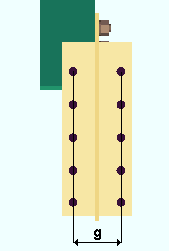
|
g = gage on supporting member. The supporting member in this example is a column (not shown). The program uses double clip angles for vertical braces to the supporting member. |
0 (zero) instructs the program to treat all situations as exceptions (see below).
A specific center-to-center distance instructs the program to attempt to use that gage.
Exceptions: If this gage doesn't work, then the program uses the gage in the local shape file for the supporting member (for example, " Flange gage " for a wide flange column). If that gage doesn't work, the program uses the angle gage .
Gage on supported member: The GOL (gage on leg in the primary dimension " Units ") as measured from the corner of the angle to the first hole in the leg to the gusset. This gage applies to the " Clip angle size " that is selected above or to the " Clip angle size " selected on the Vertical Brace Review window as long as it is greater than or equal to the " Minimum edge distance " for the bolt size used plus the 1/2-inch (13 mm) clearance between the gusset and the supporting member.
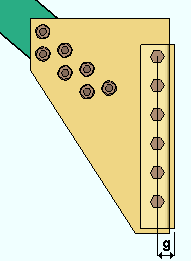
|
g = gage on supported member. The supported member is the vertical brace. |
Note: ' 0 ' (zero) instructs the program to use the " Minimum edge distance " for the bolt size used plus the 1/2-inch clearance between the gusset and the supporting member.
Stagger bolts: ![]() or
or ![]() . This applies to connection design in a full-featured SDS2 program when ' Automatic ' is selected for " Stagger bolts " on the Vertical Brace Review window.
. This applies to connection design in a full-featured SDS2 program when ' Automatic ' is selected for " Stagger bolts " on the Vertical Brace Review window.
|
|
If this box is checked (
), the program staggers the bolts on the clip angle .
If the box is not checked (
), the program does not stagger the bolts.
Use expanded bolt spacing: ![]() or
or ![]() . This applies to connection design in a full-featured SDS2 program regardless of the " Clip angle size " that is selected on the Vertical Brace Review window.
. This applies to connection design in a full-featured SDS2 program regardless of the " Clip angle size " that is selected on the Vertical Brace Review window.
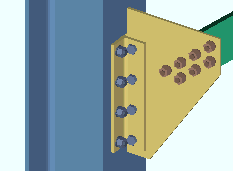 |
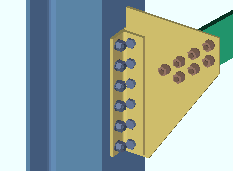 |
If this box is checked (
), the program expands the bolt spacing on the clip angle to 1.5 times the " Bolt spacing " per bolt diameter, if doing so still allows the clip angle to carry the load.
If the box is not checked (
), the program uses the " Bolt spacing " that is set for the bolt diameter, in Connection Detailing/Fabricator Options .
Allow reduced edge distance for 7/8" and 1" bolts: ![]() or
or ![]() . For metric bolts, this applies to bolts with diameters of 20 mm, 22 mm and 24 mm. This applies to the design of clip angles for attaching the gusset of a vertical brace to a supporting member other than the column in a beam-column-vertical brace condition.
. For metric bolts, this applies to bolts with diameters of 20 mm, 22 mm and 24 mm. This applies to the design of clip angles for attaching the gusset of a vertical brace to a supporting member other than the column in a beam-column-vertical brace condition.
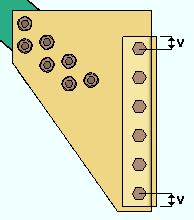
|
v = edge distance. |
If this box is checked (
), the program connection design is permitted to apply note d from Table J3.4 or Table J3.4M ( AISC Thirteenth Edition , p16.1-107). For 7/8 inch or 1 inch bolts, note d stipulates that the edge distance is permitted to be reduced from the table value to 1 1/4 in. For 20 mm or 22 mm or 24 mm bolts, note d stipulates that the edge distance is permitted to be reduced from the table value to 32 mm.
If the box is not checked (
), note d will be ignored. SDS2 connection design will use the maximum of the Table J3.4 value or the value entered to " Vertical edge distance at ends " in Clip Angle Settings .
Also: " Bolt diameter " sets the diameter of bolts for vertical brace gusset clips. Table J3.4 is Table J3.5 in the ASD 9th Edition (p5-76).
contents | setup | fabricator options | top
|
|
------ Horizontal braces ------
Locate angle braces on neutral axis: ![]() or
or ![]() . This applies to horizontal braces with angle material entered as the " Section size " when " Locate on neutral axis " is set to ' Automatic ' on the Horizontal Brace Review window.
. This applies to horizontal braces with angle material entered as the " Section size " when " Locate on neutral axis " is set to ' Automatic ' on the Horizontal Brace Review window.
|
workline ( x )
on neutral axis |
workline ( x )
on gage line |

|
|
If this box is checked (
), SDS2 design routines orient the brace's angle material so that the angle's X-X axis or Y-Y axis intersects with the work line of the brace.
If the box is not checked (
), SDS2 design routines align the gage line of the angle material with the work line of the brace.
Minimum member end edge distance: The distance (in the primary dimension " Units " or in other units ) parallel with the workline of the horizontal brace from the edge of the brace to the center of the nearest hole.
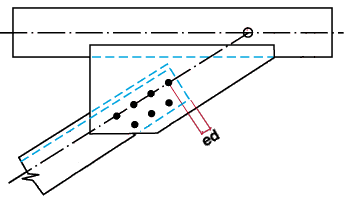
|
ed = edge distance for a horizontal brace. |
Note: If an extremely low edge distance is shown here (for example, 1/8 inch), connection design calculates the minimum edge distance based on the bolt diameter.
Gusset to single beam connection: Welded or Clip angle . This applies (in a full-featured SDS2 program ) to a horizontal brace framing to a single beam when " Gusset to beam connection " is set to ' Automatic ' on the Horizontal Brace Review window.
|
|
' Welded ' instructs connection design to attempt to shop weld the horizontal brace gusset plate to the supporting beam.
' Clip angle ' instructs connection design to attempt to field bolt the gusset to the web of the beam with a clip angle. Also see : " Gusset to beam clips " (' Bolted ' or ' Welded ') and " Gusset clips on " (' Both sides ' or ' Near side ' or ' Far side ').
Detailed: In position or Horizontal . This applies to the details of horizontal braces automatically detailed in a full-featured SDS2 program .
|
Show design loads on details: None or Input or All . This applies to the details of horizontal braces automatically detailed in a full-featured SDS2 program .
| Loads on the left end, Horizontal Brace Review window : |
|
|
| ' Input ' loads on the horizontal brace detail, left end : |

|
| ' All ' loads on the horizontal brace detail, left end : |

|
' None ' results in design loads not being shown on horizontal brace details.
' Input ' results in only those loads that have been entered by the user (on the Horizontal Brace Review window) being reported on horizontal brace details.
' All ' results all design loads -- except loads of ' 0 ' -- being noted on the horizontal brace detail.
![]() /
/ ![]() Show member quantities and/or
Show member quantities and/or ![]() /
/ ![]() Show member numbers. This applies to horizontal braces auto detailed (in a full-featured SDS2 program ) when " Show design loads on details " is set to ' Input ' or to ' All '. Multiple horizontal braces with the same system piecemark can have different design loads.
Show member numbers. This applies to horizontal braces auto detailed (in a full-featured SDS2 program ) when " Show design loads on details " is set to ' Input ' or to ' All '. Multiple horizontal braces with the same system piecemark can have different design loads.
| Each of these examples is from a detail of two horizontal braces combined under the same piecemark. One brace -- member number [159] -- has a user-input " Tension load " of 80.0 kips. The other brace -- [167] -- has a user-input " Tension load " of 75.0 kips. | ||
|
Example 1 : " Show design loads ... " is ' Input '. " |
|
|
Example 2 : " Show design loads ... " is ' Input '. " |
|
|
Example 3 : " Show design loads ... " is ' Input '. " |
|
Show capacity loads on details: None or All . This applies to the automatic detailing of horizontal braces (in a full-featured SDS2 program ). The capacity loads shown on the detail should match the Connection Design Calculations and Expanded Connection Design Calculations so long as everything -- the design calcs, the model, the detail -- is all up to date.
| Connection capacity loads ( Calcs ) : |

|
| " Show capacity loads on details " = ' All ' : |

|
' None ' means that connection capacity loads will not be shown on subsequently generated details of horizontal braces.
' All ' results in connection capacity loads being shown on horizontal brace details subsequently generated in a full-featured SDS2 program .
![]() /
/ ![]() Show member quantities and/or
Show member quantities and/or ![]() /
/ ![]() Show member numbers. This applies to horizontal braces auto detailed (in a full-featured SDS2 program ) when " Show capacity loads on details " is set to ' All '.
Show member numbers. This applies to horizontal braces auto detailed (in a full-featured SDS2 program ) when " Show capacity loads on details " is set to ' All '.
Theoretically, if the horizontal brace has a system piecemark , corresponding end connections for all horizontal braces that share that same piecemark should all have the same capacity. This means that the same total member quantity and member numbers should theoretically be listed for each capacity load.
Show grid notes on details: ![]() None or
None or ![]() One or
One or ![]() all . This applies to the details of horizontal braces that were automatically detailed in a full-featured SDS2 program .
all . This applies to the details of horizontal braces that were automatically detailed in a full-featured SDS2 program .
|
'
None ' indicates that no grid-location notes were added to horizontal brace details that were automatically detailed while ' None ' was selected.
'
One ' indicates that automatic detailing has been instructed to add to a detail a grid location note stating the plan view grid intersection that is closest to the origin reference point (left-end workpoint) of the bottom, left horizontal brace that is under the particular piecemark that was being automatically detailed. The bottom horizontal brace in a plan view is the brace with the lowest Y global coordinate . The left horizontal brace in a plan view is the brace with the lowest X global coordinate.
'
All ' indicates that automatic detailing has been instructed to add to a detail the grid intersections for each brace with the same piecemark. The horizontal brace locations are listed according to their bottom-to-top and left-to-right locations in a plan view. For horizontal braces that have the same X-Y global coordinates , the brace at the lower elevation is listed first.
Back to back angle stitch plate gap: The distance (in the primary dimensioning " Units ") between the two "backs" of a back-to-back double-angle horizontal brace when " Stitch plate gap " is set to ' Auto ' on the Horizontal Brace Review window. This also sets the thickness of the stitch plate ( spacer ).
|
||
| A gap of ' 0 ' (zero) results in the back-to-back double-angle braces being designed without a stitch plate. |
Allow material workline offset: ![]() or
or ![]() . This applies when ' Automatic ' is selected for " Allow material workline offset " on the Horizontal Brace Review window or at Home > Project Settings > Job > User Defined Connections .
. This applies when ' Automatic ' is selected for " Allow material workline offset " on the Horizontal Brace Review window or at Home > Project Settings > Job > User Defined Connections .
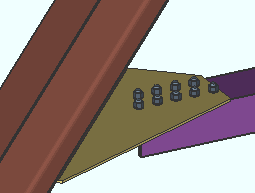
|
A material workline offset is allowed when a horizontal brace frames to the bottom flange of a beam. To get a connection in such a situation, the beam workline must be in the same plane as the beam's bottom flange. |
If this box is checked (
), then connection design (in a full-featured SDS2 program) offsets the main material of the horizontal brace by the thickness of the gusset plate so that the brace can connect to the bottom flange of the beam.
If the box is not checked (
), connection design (in a full-featured SDS2 program ) will not offset the main material of the horizontal brace. The connection on the end of a brace that frames to the bottom flange of the beam will fail with the message " Invalid brace work point location ."
HSS erection bolts: None or One or Two . This applies when ' Automatic ' is selected for " Erection bolts " on a Horizontal Brace window (or for a user defined connection). Erection bolts may be designed on a HSS/pipe/tube horizontal brace that is field welded to the gusset.
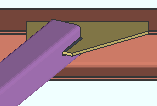
|
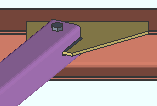
|
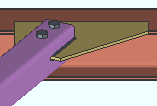
|
In a full-featured SDS2 program . . .
' None ' instructs connection design (when ' Automatic ' is selected) to not generate an erection bolt or design holes into the pipe or tube horizontal brace.
' One ' instructs connection design (when ' Automatic ' is selected) to generate an A307 field erection bolt along with holes for inserting the bolt into.
' Two ' instructs connection design to generate two A307 field erection bolts along with holes for inserting the bolts into.
Hole type for HSS erection bolts: Standard round or Short slot or Long slot or Oversized round or User slot #1 or User slot #2 . This applies (to the gusset, not the brace) when " HSS erection bolts " has been set to ' One ' or ' Two '.

Effect on connection design: The hole type selected here applies to the holes in the gusset only. The holes in the brace are always standard round. Erection bolts may be designed on a HSS/pipe/tube horizontal brace that is field welded to the gusset.
HSS double paddle clearance: The clearance (in the primary dimension " Units " or other units ) for the gusset plate that is sandwiched between the double paddle plates in a horizontal brace's double paddle plate connection.
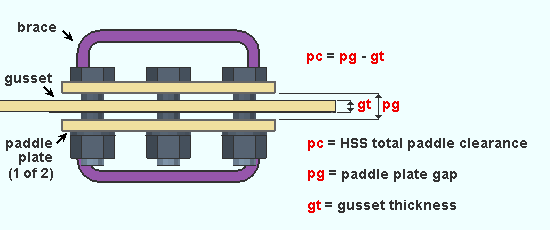
|
| " HSS double paddle clearance " is equal to the paddle plate gap minus the gusset thickness. |
Effect on connection design in a full-featured SDS2 program: The entry made here controls the spacing between the double paddle plates that connection design creates when ' Double paddle plate ' has been selected as a horizontal brace's " Pipe/tube end fitting ."
Welded angle end weld: ![]() or
or ![]() . This applies when ' Automatic ' is selected for " Include end welds " under "
. This applies when ' Automatic ' is selected for " Include end welds " under " ![]() Connection specifications " on the Horizontal Brace Review window.
Connection specifications " on the Horizontal Brace Review window.
|
|
In a full-featured SDS2 program . . .
If this box is checked (
) and " Include end welds " is set to ' Automatic ', three sides of the angle are welded to the gusset plate. A weld is placed at the end of the angle along with the welds along the length of the angle.
If the box is not checked (
) and " Include end welds " is set to ' Automatic ', two sides of the angle are welded to the gusset plate. The two welds are along the length of the angle.
Welded angle balanced welds: This applies when ' Automatic ' is selected for " Balanced welds " under " ![]() Connection specifications " on the Horizontal Brace Review window.
Connection specifications " on the Horizontal Brace Review window.
|
|
In a full-featured SDS2 program . . .
If this box is checked (
) and " Balanced welds " is set to ' Automatic ', the program is instructed to attempt to design a weld group that is balanced. A weld group is balanced when its center of resistance aligns with the center of force.
If the box is not checked (
) and " Balanced welds " is set to ' Automatic ', the program is instructed to design welds of equal length along the length of the brace.
Maximum web stiffener thickness: The maximum thickness (in the primary dimension " Units " or other units ) of stiffeners for horizontal brace gusset plates that weld to a beam's web.
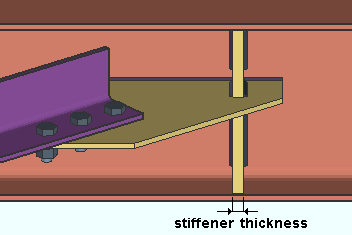
|
In a full-featured SDS2 program, connection design may create stiffeners for a horizontal brace gusset plate to a beam's web when " Check supporting member web stress " is set to ' As required ' in the horizontal brace's " Connection specifications ." |
Also see: A horizontal brace gusset plate connection may fail with the message " Supporting web/flg overstressed by axial load " if the " Maximum web stiffener thickness " that is entered here is too low.
------ Clip angle connection of gusset to supporting member ------
Gusset to clip connection: Welded or Bolted . This applies to connection design in a full-featured SDS2 program when " Gusset to clip connection " is set to ' Automatic ' on the Horizontal Brace Review window.
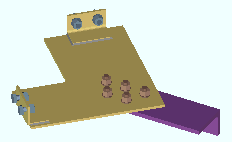
|
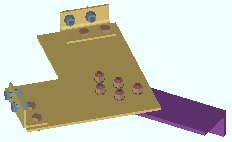
|
' Bolted ' instructs connection design to shop bolt the clip angle to the gusset plate and field bolt the clip angle to the beam web.
' Welded ' instructs connection design to shop weld the clip angles to the gusset plate and field bolt the clip angle to the beam web.
Gusset clips on: Both sides or Near side or Far side . This applies to connection design in a full-featured SDS2 program when " Gusset clips on " is set to ' Automatic ' on the Horizontal Brace Review window.
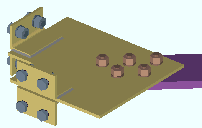
|
' Both sides ' attaches the clip angles to both the near and far sides of the gusset plate. |

|
' Near side ' instructs the program to try to place the clip angles on the near side of the gusset. |
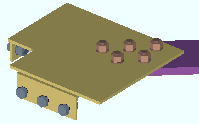
|
' Far side ' instructs the program to try to place the clip angles on the far side of the gusset. |
Clip angle size: The section size of the angle material to be used when " Clip angle size " is set to ' Automatic ' on the Horizontal Brace Review window.
Attach long leg to: Supported or Supporting . This applies to connection design in a full-featured SDS2 program when ' Automatic ' is selected for " Attach long leg to " on the Horizontal Brace Review window.
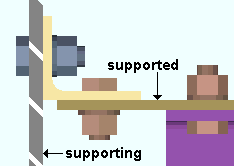
|
The supported is the gusset plate. The supporting is the web of the beam. |
' Supported ' instructs connection design to attempt to attach the long leg of the angle to the gusset plate.
' Supporting ' instructs connection design to attempt to attach the long leg of the angle to the beam web.
Hole type supported: Standard round or Short slot or Long slot or Oversized or User Slot #1 or User Slot #2 . This is the hole type for shop bolting the leg of the clip angle to the vertical brace gusset plate when " Hole type supported " is set to ' Auto ' on the Horizontal Brace Review window.

Hole type supporting: Standard round or Short slot or Long slot or Oversized or User Slot #1 or User Slot #2 . This is the hole type for field bolting the outstanding leg of the clip angle to the supporting beam when " Hole type supporting " is set to ' Auto ' on the Horizontal Brace Review window.

Double gage on supporting member: The center-to-center distance (in the primary dimension " Units " or in other units ) between the columns of holes in the outstanding legs of the near side and far side clip angles on the horizontal brace gusset plate.
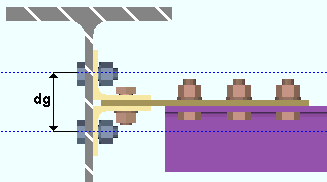
|
dg = double gage on supporting member. |
Single gage on supporting member: The distance (in the primary dimension " Units " or in other units ) from where the " Gage is measured from " to the first column of holes in the leg that fastens to the supporting beam.
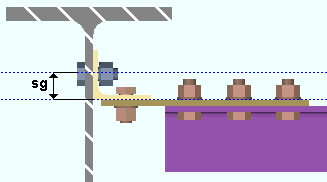
|
sg = single gage on supporting member. |
Gage measured from: Gusset CL or GOL .
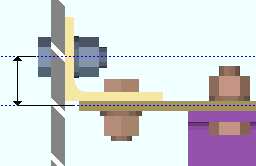
|
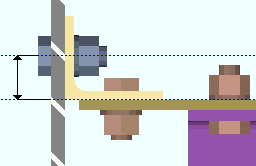
|
' Gusset CL ' instructs the program to measure the " Single gage on supporting member " from the center line of the gusset.
' GOL ' instructs the program to measure the " Single gage on supporting member " from the face of the leg of the clip angle that fastens to the gusset.
Gage on supported member: The distance (in the primary dimension " Units " or in other units ) from the face of the outstanding leg of the clip angle to the first column of holes in the leg that fastens to the gusset plate.
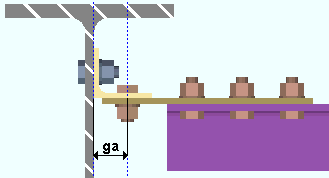
|
ga = gage on supported member. |
Stagger bolts: ![]() or
or ![]() . This applies when ' Automatic ' is selected for " Stagger bolts " on the Horizontal Brace window.
. This applies when ' Automatic ' is selected for " Stagger bolts " on the Horizontal Brace window.
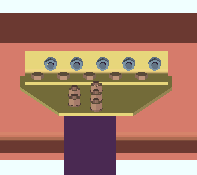 |
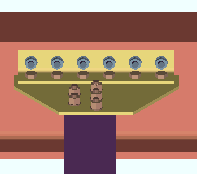 |
Allow reduced edge distance for 7/8" and 1" bolts: ![]() or
or ![]() . For metric bolts, this applies to bolts with diameters of 20 mm, 22 mm and 24 mm. This applies to connection design in a full-featured SDS2 program of clip angles for attaching the gusset of a horizontal brace to a beam.
. For metric bolts, this applies to bolts with diameters of 20 mm, 22 mm and 24 mm. This applies to connection design in a full-featured SDS2 program of clip angles for attaching the gusset of a horizontal brace to a beam.
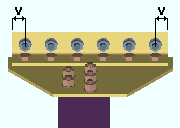
|
v = edge distance. |
If this box is checked (
), connection design is permitted to apply note d from Table J3.4 or Table J3.4M ( AISC Thirteenth Edition , p16.1-107). For 7/8 inch or 1 inch bolts, note d stipulates that the edge distance is permitted to be reduced from the table value to 1 1/4 in. For 20 mm or 22 mm or 24 mm bolts, note d stipulates that the edge distance is permitted to be reduced from the table value to 32 mm.
If the box is not checked (
), note d will be ignored. Connection design will apply the maximum of the Table J3.4 value or the value entered to " Vertical edge distance at ends " in Clip Angle Settings .
Also see: " Bolt diameter " sets the diameter of bolts for horizontal brace gusset clips. Table J3.4 is Table J3.5 in the ASD 9th Edition (p5-76).
Clip to gusset dimension: The dimension (in the primary dimension " Units " or in other units ) from the web of the supporting beam to the edge of the horizontal brace gusset plate. This applies to horizontal brace gusset plates that bolt to a beam web with a clip angle.
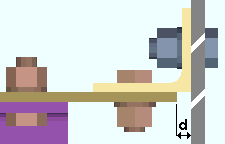
|
d = clip to gusset dimension. |
page 1 | contents | home > project settings > fabricator > detailing > | classic | top
|
|
------ Elevation on member details ------
Noted at top rail from: Not noted or Top of top rail or Center of top rail . This applies to the automatic detailing of handrail in a full-featured SDS2 program .
|
' Not noted ' instructs auto detailing not to generate a pointer and label that identifies the elevation of the top rail on subsequently generated handrail member details.
' Top of top rail ' instructs Detail Members to generate a pointer and label that identifies the elevation of the top of the top rail.
' Center of top rail ' instructs Detail Members to generate a pointer and label that identifies the elevation of the center of the top rail.
Noted at bottom of post: ![]() or
or ![]() . This applies to the automatic detailing of handrail in a full-featured SDS2 program .
. This applies to the automatic detailing of handrail in a full-featured SDS2 program .
|
If this box is checked (
), the program draws a label that identifies the elevation of the bottom post on the subsequently generated handrail detail.
If the box is not checked (
), the program does not identify the bottom post elevation on the subsequently generated handrail detail.
page 1 | contents | home > project settings > fabricator > detailing > | classic | top
|
|
Preferred stringer auxiliary view orientation from: ![]() Outside or
Outside or ![]() Inside . This affects automatic detailing of stair member in a full-featured SDS2 program .
Inside . This affects automatic detailing of stair member in a full-featured SDS2 program .
'
Outside ' instructs a full-featured SDS2 program to generate a Member Isolation view type named ' MAIN VIEW, CROSS SECTION '. That view looks at the stair from the near side of the NS stringer and therefore has the same left-right orientation as the ' MAIN VIEW '. The choice of ' Outside ' produces the same automatic detailing results that you would traditionally expect to see in an SDS2 stair member detail.
'
Inside ' instructs a full-featured SDS2 program to generate a new member isolation view type called ' INSIDE STRINGER, CROSS SECTION '. The view looks at the NS stringer from the far side of the NS stringer and has an orientation that mirrors that of the ' MAIN VIEW '. Automatic detailing places an ' Inside ' view to the right of the shorten limit line, vertically aligned with its MAIN VIEW .
New stair stringer length on BOM and detail: Pre-cut or Post-cut . This applies when the " End condition " for a stair stringer is ' Bolt to floor '. It sets the default selection that is made for " NS/FS stringer length on BOM " on the Stair Edit window, and it affects the callout in the submaterial detail as well as the " Length " reported in the member bill of material .
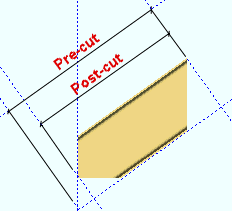
|
Example: A short stair with a bolt-to-floor end condition.
|
' Pre-cut ' results in the " Length " reported for the near side and far side stringers in a stair's bill of material being the " Order length " of that material. The pre-cut length will also be reported, along with the description, in the callout on a subsequently auto detailed submaterial detail of the stringer. The "pre-cut length" corresponds to what is referred to as the saw length on the CNC Setup window. This is the length of the stringer material before cuts were made to its end so that it could be bolted to the floor.
' Post-cut ' results in the stringer's " Length " in the bill being its " Part length ." The description and pre-cut length will also be reported in the callout on the submaterial detail. For CNC, the "post-cut length" is referred to as the final length. This is the length of the stringer material after its end was cut so that it could be bolted to the floor.
page 1 | contents | home > project settings > fabricator > detailing > | classic | top
|
|
Type of spacer for double bracing: Bolted ring or Bolted plate or Welded plate . This sets the type of spacer to be used for angle or channel " Double material " vertical bracing or angle " Double material " horizontal bracing. On double-angle horizontal braces, either ' Both sides ' must be selected or the " Stitch plate gap " must be greater than zero. The spacers are generated (in a full-featured SDS2 program ) when Create Solids takes place.
' Bolted ring '

|
' Bolted plate '
 |
' Welded plate '
 |
' Bolted ring ' causes a bolted round bar to be used as the spacer for a ' Back to back ' double-angle or double-channel vertical brace or a double-angle horizontal brace on ' Both sides ' of the gusset (or whose " Stitch plate gap " is greater than zero). For a ' Star ' configuration vertical brace, a bolted plate stitch plate is used.
' Bolted plate ' causes a bolted rectangular plate to be used as the spacer. As with a bolted ring, holes are generated through the plate and both materials of the " Double material " brace. A shop bolt is generated through the holes.
' Welded plate ' causes a simple rectangular plate (without holes or bolts) to be used as the spacer between the two materials that make up the vertical brace or horizontal brace.
Type of spacer for welded connections: Bolted ring or Bolted plate or Welded plate . This applies to the design of welded back-to-back double-angle vertical bracing to the stem of a W tee.
' Bolted ring '
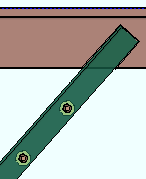
|
' Bolted plate '
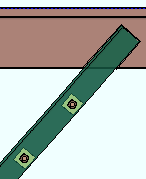
|
' Welded plate '
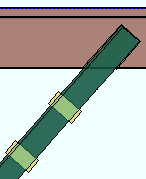
|
| The members in these screen shots are displayed in solid transparent main so that you can see the spacers. | ||
' Bolted ring ' shop bolts the two angles together using a round bar with a hole in it as the spacer (stitch plate).
' Bolted plate ' shop bolts the two angles together using a rectangular plate with a hole in it as the spacer (stitch plate).
' Welded plate ' causes a simple rectangular plate (without holes or bolts) to be used as the spacer (stitch plate) between the two angles that make up the double-angle vertical brace.
Max allowed stitch plate spacing: ![]() or
or ![]() . This distance (in the primary dimension " Units " or in other units ) sets the default spacing (center-to-center) between stitch plates and the left/right end of the brace. Left/right end = end of the brace material for a ' Plain end ' or ' Welded ' connection. Left/right end = inside bolt if the end has a gusset.
. This distance (in the primary dimension " Units " or in other units ) sets the default spacing (center-to-center) between stitch plates and the left/right end of the brace. Left/right end = end of the brace material for a ' Plain end ' or ' Welded ' connection. Left/right end = inside bolt if the end has a gusset.
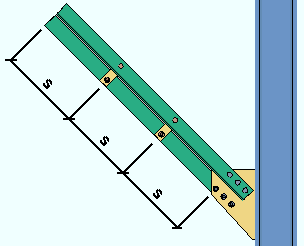
|
s = spacing |
Minimum number of allowed stitch plates: This number ( 1 or 2 or 3 ...) applies to vertical braces and horizontal braces with stitch plates. It sets the default minimum number of stitch plates that will be generated, regardless of the " Max allowed stitch plate spacing ."
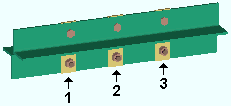
|
" Number of stitch plates " = ' 3 ' |
Stitch plate extension beyond brace: ![]() or
or ![]() . This applies no matter what " Type of spacer " is selected. It sets the distance the stitch plate extends beyond the horizontal or vertical brace.
. This applies no matter what " Type of spacer " is selected. It sets the distance the stitch plate extends beyond the horizontal or vertical brace.
X = extension beyond brace
 |
Stitch plate width: ![]() or
or ![]() . This applies no matter what " Type of spacer " is selected. It applies to both horizontal and vertical braces. This is the diameter of the round bar if ' Bolted ring ' is the " Type of spacer " that is selected.
. This applies no matter what " Type of spacer " is selected. It applies to both horizontal and vertical braces. This is the diameter of the round bar if ' Bolted ring ' is the " Type of spacer " that is selected.
W = width of stitch plate
page 1 | contents | home > project settings > fabricator > detailing > | classic | top
|
|
Detailed: In position or Horizontal or Vertical . This applies to miscellaneous members that undergo automatic detailing in a full-featured SDS2 program .
|
' In position ' shows on the miscellaneous member's detail the same main view that is shown in member isolation .
' Horizontal ' or ' Vertical ' results in the miscellaneous member being shown flat on its detail.
Add bearing bar thickness to description in BOM for grating material: ![]() or
or ![]() .
.

|

|
If this box is checked (
), then automatic detailing in a full-featured SDS2 program will include a grating's " Bearing bar thickness " in the description that it automatically enters to a member bill of material. The bill of material " Description " will be in the form: GR+DEPTH x THICK x WIDTH , where GR is the description prefix for grating, DEPTH is the " Bearing bar depth ," THICK is the " Bearing bar thickness " and WIDTH is the " Grating width ."
If the box is not checked (
), then the description for a grating that will automatically be entered to a member bill of material will not include the " Bearing bar thickness " of the grating.
Add bearing bar thickness to description in BOM for grating tread material: ![]() or
or ![]() .
.

|

|
If this box is checked (
), then automatic detailing in a full-featured SDS2 program will include a grating tread's " Bearing bar thickness " in the description that it automatically enters to a member bill of material. The bill of material " Description " will be in the form: GT+DEPTH x THICK x WIDTH , where GT is the description prefix for grating tread, DEPTH is the " Bearing bar depth ," THICK is the " Bearing bar thickness " and WIDTH is the " Grating width ."
If the box is not checked (
), then the description for a grating tread that will automatically be entered to a member bill of material will not include the " Bearing bar thickness " of the grating tread.
page 1 | contents | home > project settings > fabricator > detailing > | classic | top
|
|
Length of bottom rod for rod bracing: A distance (in the primary dimension " Units " or other units ). This sets the default for the " Rod length " and " Middle rod length " locks in the leaf named " Brace Connection To Gusset ."
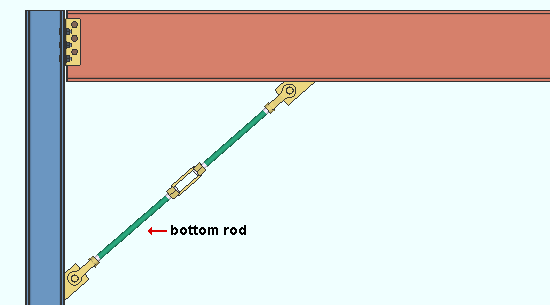
Length of rod brace thread: A distance (in the primary dimension " Units " or other units ). This sets the default for the " Thread length " lock in the leaf named " Brace Connection To Gusset ." That lock applies to each end of each rod that makes up a rod brace.
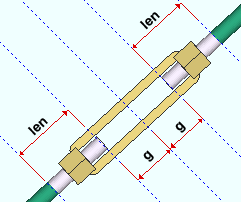
|
len = length of rod brace thread. |
Gap between rod braces at turnbuckle: The distance (in the primary dimension " Units " or other units ) from the end of the rod brace to the center of the turnbuckle. This distance is half the distance between the two round bars that are joined at a turnbuckle to form a rod brace.

|
g = gap between rode braces at turnbuckle. |

'
Headed ' results in a clevis pin with a head. Connection design locks for " Clevis pin shoulder height " and " Clevis pin head thickness " will be available for adjusting the head size in the rod brace leaf named Brace Connection To Gusset .
'
Cottter ' results in a straight clevis pin with a uniform diameter along its entire length.
page 1 | contents | home > project settings > fabricator > detailing > | classic | top


